
Benedetto Giacomo Marcello was an Italian composer, writer, advocate, magistrate, and teacher.

L'estro armonico, Op. 3, is a set of 12 concertos for string instruments by Italian composer Antonio Vivaldi, first published in Amsterdam in 1711. Vivaldi's Twelve Trio Sonatas, Op. 1, and Twelve Violin Sonatas, Op. 2, only contained sonatas, thus L'estro armonico was his first collection of concertos appearing in print. It was also the first time he chose a foreign publisher, Estienne Roger, instead of an Italian. Each concerto was printed in eight parts: four violins, two violas, cello and continuo. The continuo part was printed as a figured bass for violone and harpsichord.

Casanova is a 2005 American romance film directed by Lasse Hallström starring Heath Ledger and loosely based on the life of Giacomo Casanova. The film premiered September 3, 2005, at the Venice Film Festival. It received mixed reviews and flopped at the box office.
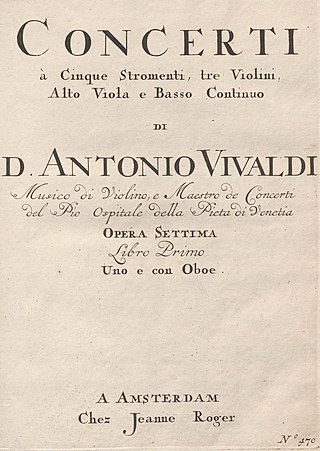
A set of twelve concertos was published by Estienne Roger in 1716-1717 under Antonio Vivaldi's name, as his Opus 7. They were in two volumes, each containing concertos numbered 1-6. Of the set, ten were for violin solo; the other two were for oboe solo. The authenticity of some of the works included has long been doubted by scholars. Three are now considered spurious for stylistic reasons. They are: No. 1 in B-flat major for oboe, RV Anh. 143 ; No. 7 in B-flat major for oboe, RV Anh. 142 ; and No. 9 in B-flat major for violin, RV Anh. 153.

La stravaganza [literally 'Extravagance'], Op. 4, is a set of concertos written by Antonio Vivaldi in 1712–1713. The set was first published in 1716 in Amsterdam and was dedicated to Venetian nobleman Vettor Delfino, who had been a violin student of Vivaldi's. All of the concertos are scored for solo violin, strings, and basso continuo; however, some movements require extra soloists.
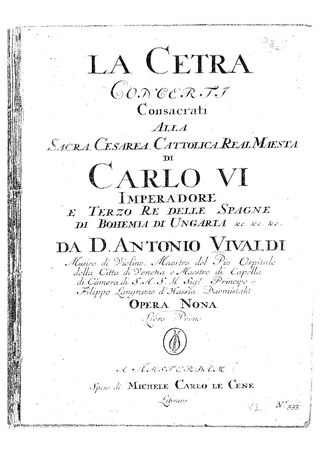
La cetra, Op. 9, is a set of twelve violin concertos by Antonio Vivaldi, published in 1727. All of them are for violin solo, strings, and basso continuo, except No. 9 in B flat, which features two solo violins. The set was named after the cetra, a lyre-like instrument, and was dedicated to Emperor Charles VI.
An organ concerto is an orchestral piece of music in which a pipe organ soloist is accompanied by an an orchestra, although some works exist with the name "concerto" which are for organ alone.
Fitzwilliam Sonatas is the name first given by Thurston Dart to an arrangement he made, based on two recorder sonatas by George Frideric Handel, which he recast as a group of three sonatas. The term was applied by later editors to the original two sonatas as Handel wrote them, and was also expanded to encompass several other sonatas for various instruments included in the Handel autograph manuscripts held by the Fitzwilliam Museum in Cambridge.

Anyone for Mozart, Bach, Handel, Vivaldi? is a CD compilation re-issue of music by the Swingle Singers. It combines tracks from two previous LP releases, Going Baroque and Swinging Mozart.
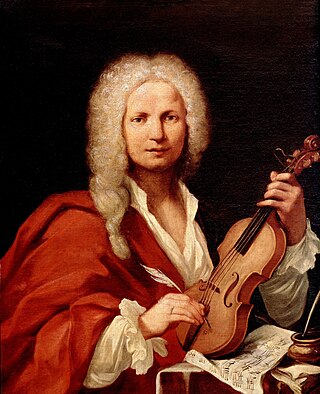
Antonio Vivaldi wrote a set of concerti, Op. 11, in 1729.
Antonio Vivaldi wrote a set of concerti for violin, strings and continuo, Op. 12, in 1729.

The Lute Concerto in D major, RV 93, is one of four works featuring the solo lute, 2 violins, and basso continuo written by Antonio Vivaldi. Vivaldi wrote the piece in the 1730s, a period in which he wrote two of his other works featuring the lute: the trios for violin and lute in G minor and C major.
The concerto transcriptions of Johann Sebastian Bach date from his second period at the court in Weimar (1708–1717). Bach transcribed for organ and harpsichord a number of Italian and Italianate concertos, mainly by Antonio Vivaldi, but with others by Alessandro Marcello, Benedetto Marcello, Georg Philipp Telemann and the musically talented Prince Johann Ernst of Saxe-Weimar. It is thought that most of the transcriptions were probably made in 1713–1714. Their publication by C.F. Peters in the 1850s and by Breitkopf & Härtel in the 1890s played a decisive role in the Vivaldi revival of the twentieth century.
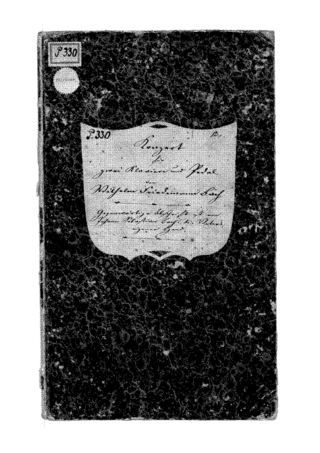
The organ concertos of Johann Sebastian Bach are solo works for organ, transcribed and reworked from instrumental concertos originally composed by Antonio Vivaldi and the musically talented Prince Johann Ernst of Saxe-Weimar. While there is no doubt about the authenticity of BWV 592–596, the sixth concerto BWV 597 is now probably considered to be spurious. Composed during Bach's second period at the court in Weimar (1708–1717), the concertos can be dated more precisely to 1713–1714.
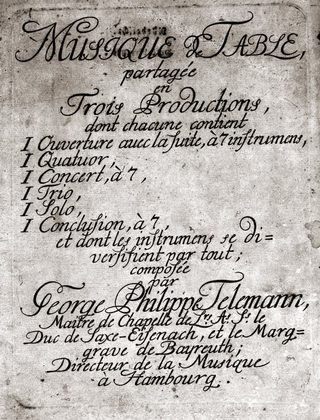
Tafelmusik is a collection of instrumental compositions by Georg Philipp Telemann (1681–1767), published in 1733. The original title is Musique de table. The work is one of Telemann's most widely known compositions; it is the climax and at the same time one of the last examples of courtly table music.

Grosso mogul, also Il grosso mogul, or capitalised [Il] Grosso Mogul, RV 208, is a violin concerto in D major by Antonio Vivaldi. The concerto, in three movements, is an early work by the Venetian composer. Around the mid-1710s Johann Sebastian Bach transcribed the concerto for organ, BWV 594, in C major. A simplified version of the violin concerto, RV 208a, without the elaborated cadenzas that appear in manuscript versions of RV 208, and with a different middle movement, was published around 1720 in Amsterdam as concerto #11 of Vivaldi's Op. 7.

Antonio Vivaldi composed three settings of the Dixit Dominus, the Latin version of Psalm 110. They include a setting in ten movements for five soloists, double choir and orchestra, RV 594, another setting in eleven movements for five voices, five-part choir and orchestra, RV 595, and a recently discovered setting in eleven movements for five soloists, choir and orchestra, RV 807, which had been attributed to Baldassare Galuppi. It is said to be one of his "most significant sacred works."

Antonio Vivaldi's Concerto for Two Cellos in G minor, RV 531 is a concerto for two cellos, string orchestra and basso continuo in three movements, believed to have been composed in the 1720s. It is Vivaldi's only concerto for two cellos, and begins unusually with an entry of the solo instruments alone.

Antonio Vivaldi's Concerto for Two Trumpets in C major, RV 537, is a concerto for two trumpets, string orchestra and basso continuo in three movements, believed to have been composed in the 1720s. It is Vivaldi's only trumpet concerto. It was published by Ricordi in 1950 after its manuscript was found in a Turin library.












